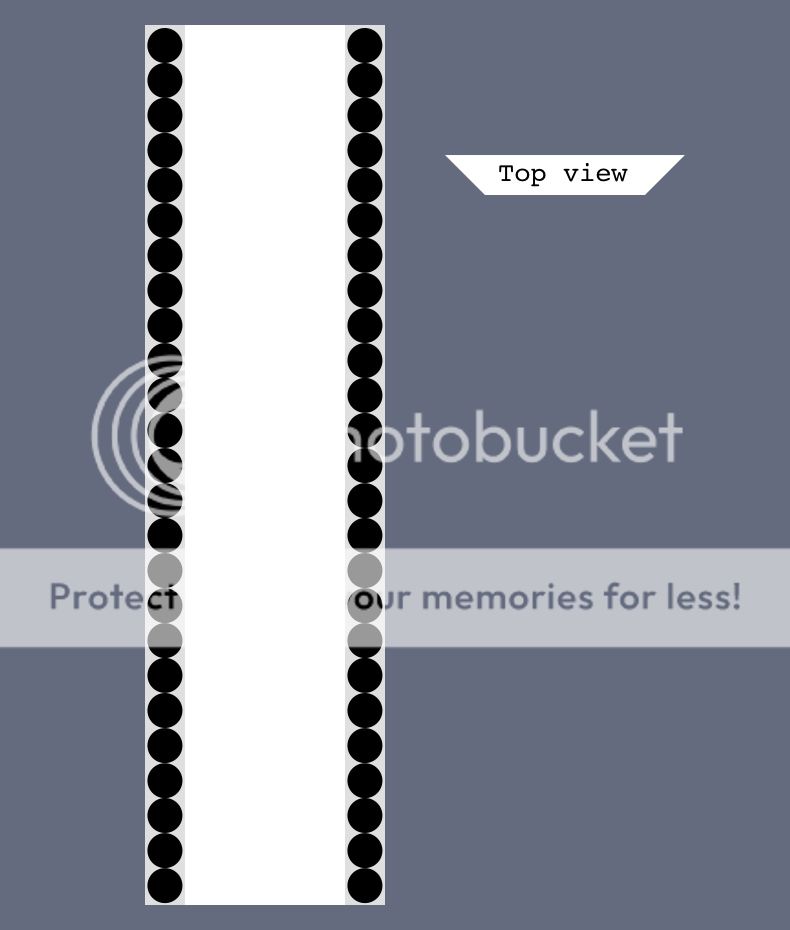This is the design.
vifa tc9 x 50
45 degree flooder.
On wall.
Both channels are in 1 box.
This is an ambiopole.
I will be using the mini-ambio RACE algorithm.

vifa tc9 x 50
45 degree flooder.
On wall.
Both channels are in 1 box.
This is an ambiopole.
I will be using the mini-ambio RACE algorithm.

Great ideas Melo!
"on the Wall" means that there´s no need for BSC, but what about CTC combing?
Are you going to address that with EQ only?
"on the Wall" means that there´s no need for BSC, but what about CTC combing?
Are you going to address that with EQ only?
Hey thanx solhaga!
As far as CTC comb filtering, I don't see it being much of a problem with this configuration because the listener is 45 degrees off axis so CTC combing will only be audible coming off the reflected sidewall, and buy the time it reaches the ears it will be more diffused and also the driver beaming will have a greater distance to sum. Also the signal will be down 3db in amplitude.
It will need eq never the less. All line sources have comb filtering regardless of CTC spacing or even a continuous line (like a ribbon or planar)
There is just more combing at a closer distance with larger CTC spacing.
But, this is just an experiment.....we will see how it goes 🙂
As far as CTC comb filtering, I don't see it being much of a problem with this configuration because the listener is 45 degrees off axis so CTC combing will only be audible coming off the reflected sidewall, and buy the time it reaches the ears it will be more diffused and also the driver beaming will have a greater distance to sum. Also the signal will be down 3db in amplitude.
It will need eq never the less. All line sources have comb filtering regardless of CTC spacing or even a continuous line (like a ribbon or planar)
There is just more combing at a closer distance with larger CTC spacing.
But, this is just an experiment.....we will see how it goes 🙂
So what about having two narrower of'em as a stereo pair, perhaps standalone with a little bit of wall/baffle?
Couldn't the advantages that you mentioned still be enjoyed?
Couldn't the advantages that you mentioned still be enjoyed?
It's unecessary to worry too much about the comb filtering. Some people seem like scaring other away from array speaker by this.
See it this way, in an ordanary stereo system, 2 tweeters are separated by more than 2 meters in most cases. And they are playing the same signal in a mono (or almost mono) situation, which is very commonly seen in any central images - pop vocal, solo instrument... etc. So, how about that? Is anyone worrying about comb filtering here? 😀
Comb filtering effect does exist and detectable in vertical array, if CTC is large enough, if operating frequency is high enough. But, it can be cured to an extent which is more than acceptable.
And other (strong) benefits of arrays can easily justify that (little) trouble. No big deal. Trade-offs are unavoidable in everything, everywhere. This is a good one.
See it this way, in an ordanary stereo system, 2 tweeters are separated by more than 2 meters in most cases. And they are playing the same signal in a mono (or almost mono) situation, which is very commonly seen in any central images - pop vocal, solo instrument... etc. So, how about that? Is anyone worrying about comb filtering here? 😀
Comb filtering effect does exist and detectable in vertical array, if CTC is large enough, if operating frequency is high enough. But, it can be cured to an extent which is more than acceptable.
And other (strong) benefits of arrays can easily justify that (little) trouble. No big deal. Trade-offs are unavoidable in everything, everywhere. This is a good one.
Yeah CLS, I hear what you are saying about comb filtering regarding the classic stereo set up. That's the main reason that I believe so strongly in ambiophonics!
See it this way, in an ordanary stereo system, 2 tweeters are separated by more than 2 meters in most cases. And they are playing the same signal in a mono (or almost mono) situation, which is very commonly seen in any central images - pop vocal, solo instrument... etc. So, how about that? Is anyone worrying about comb filtering here? 😀
Yes, exactly ! This I have been wondering all along 🙂 Stereo triangle with 2 speakers produces the worst kind of combs: very simple structured and defined patterns and deep notches.
Better to use non-combing means of reproduction i.e. cross talk cancelling, or by fading out the perception by building in some stealth 😉
- Elias
Yes, exactly ! This I have been wondering all along 🙂 Stereo triangle with 2 speakers produces the worst kind of combs: very simple structured and defined patterns and deep notches.
Better to use non-combing means of reproduction i.e. cross talk cancelling, or by fading out the perception by building in some stealth 😉
- Elias
I think it's mostly a "non-starter". The engineer is using eq. to get the desired effect and doing so on a stereo loudspeaker pair with the very same combing.
Now if it's a binaural recording then that's a different matter - it needs low cross-talk.
Obviously if you want really good separation then go with high isolation headphones, but then you'll be stuck with "in the head" imaging (again, unless binaural). 😱 (..which is why several headphone amp makers add-in some form of "cross-feed" - to get rid of the "in the head" sound.)
I think it's mostly a "non-starter".
I know a diesel car can be a "non-starter" in Finland when it's -40 C in the morning and you left your car on the yard over night 😀
I know a diesel car can be a "non-starter" in Finland when it's -40 C in the morning and you left your car on the yard over night 😀
That's just front-yard brick. 😀
I think it's mostly a "non-starter". The engineer is using eq. to get the desired effect and doing so on a stereo loudspeaker pair with the very same combing.
Now if it's a binaural recording then that's a different matter - it needs low cross-talk.
Obviously if you want really good separation then go with high isolation headphones, but then you'll be stuck with "in the head" imaging (again, unless binaural). 😱 (..which is why several headphone amp makers add-in some form of "cross-feed" - to get rid of the "in the head" sound.)
Here we go again 😀
My beliefs are that if the sound engineer is eq'ing for a stereo pair than why the exaggerated bass and mid-bass when both speakers are playing in mono.
When I use the RACE algorithm, bass and mid-bass are equal in amplitude across the soundstage, as it is with headphones.
Also, if they even eq for combing higher frequencies, they still can't do anything about ITD which is the major problem because it causes smearing and makes the center image 6ft wide.
Also, if they are eq'ing for HF combing....what about cars, where the listener is way out of the sweet spot. Or TV speakers where most listeners are also way out of the sweet spot.
In fact, most listeners of an audiophile set up will be off axis, They have to be at audio shows.
Given all these examples, I can't believe that sound engineers would eq for HRTF for the reason of solely sweet spot critical listening.
I think the exaggerated bass is due to the lower level in vocal volume perceived with the stereo pair (without race). I noticed this going from 1 speaker to 2, then playing with the ambio center wall divider. 1 speaker or (2 speakers with a divider) seemed to have 3db if not more voice volume.
I think recording studios do a better job scattering side reflections (when listening) than what we normally hear in a house (some to none).
Norman
I think recording studios do a better job scattering side reflections (when listening) than what we normally hear in a house (some to none).
Norman
I think the exaggerated bass is due to the lower level in vocal volume perceived with the stereo pair (without race).
I think this is due to stereo triangle comb filtering generates attenuation inside each critical bandwidth. Since stereo speakers are far apart, interference notch density can be high so there are multible notches inside each band, thus overall loudness level gets lower.
If cross talk is removed, no attenuation occurs at any bandwidth.
- Elias
Last edited:
Here we go again 😀
My beliefs are that if the sound engineer is eq'ing for a stereo pair
..than why the exaggerated bass and mid-bass when both speakers are playing in mono.
When I use the RACE algorithm, bass and mid-bass are equal in amplitude across the soundstage, as it is with headphones.
Also, if they even eq for combing higher frequencies, they still can't do anything about ITD which is the major problem because it causes smearing and makes the center image 6ft wide.
Also, if they are eq'ing for HF combing....what about cars, where the listener is way out of the sweet spot. Or TV speakers where most listeners are also way out of the sweet spot.
In fact, most listeners of an audiophile set up will be off axis, They have to be at audio shows.
Given all these examples, I can't believe that sound engineers would eq for HRTF for the reason of solely sweet spot critical listening.
That's what a "non-starter" references. 😛
You aren't supposed to play them both in MONO - the engineer designed it for STEREO. 😉
Still, I'll grant you that the midbass is generally "wrong" with stereo as well. 😉 It's made worse with near-time contralateral reflections which "widen" images. (..its not just walls either, but can also be the opposing speaker.)
Oh, ok. You were saying don't start this discussion 🙂 haha.
When I say mono, I mean when both stereo speakers play the same bass and mid-bass frequencies.
When I say mono, I mean when both stereo speakers play the same bass and mid-bass frequencies.
- Status
- Not open for further replies.
- Home
- Loudspeakers
- Full Range
- The Supernova! (a full range flooder line source)
